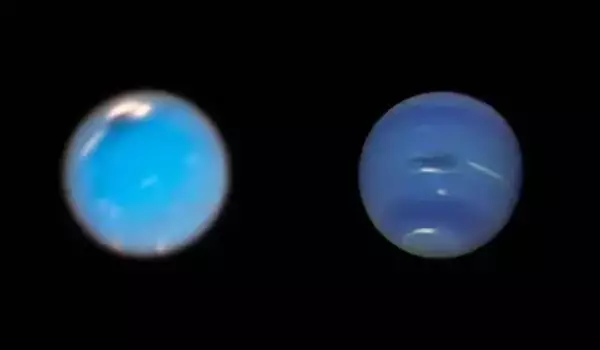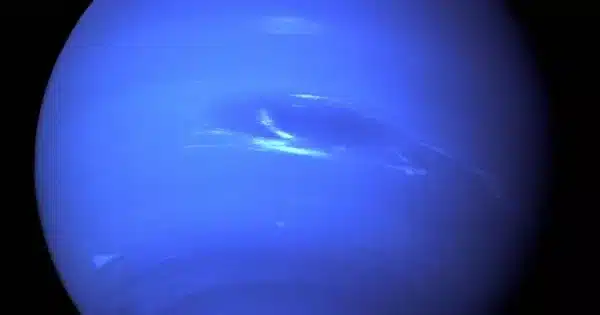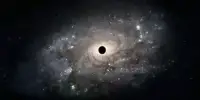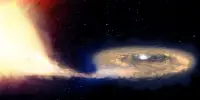Earth-based telescopes had detected and examined Neptune’s black patches. These black spots are transitory structures in Neptune’s atmosphere, similar to Jupiter’s Great Red Spot but smaller and less stable. They appear as dark, stormy patches in the planet’s primarily blue atmosphere.
Using ESO’s Very big Telescope (VLT), researchers discovered a big dark area in Neptune’s atmosphere, along with an unexpected smaller brilliant spot nearby. This is the first time a dark spot on the planet has been detected using a telescope on Earth. Astronomers have been puzzled by these sporadic structures in the blue background of Neptune’s atmosphere, and the new findings shed more light on their nature and origin.
Large spots, the most renowned of which is Jupiter’s Great Red Spot, are typical characteristics in the atmospheres of big planets. A dark spot on Neptune was found by NASA’s Voyager 2 in 1989, but it vanished a few years later. “Since the discovery of the first dark spot, I’ve always wondered what these short-lived and elusive dark features are,” says Patrick Irwin, Professor at the University of Oxford in the United Kingdom and lead investigator of the study published today in Nature Astronomy.
This is a remarkable improvement in humanity’s ability to observe the cosmos. Initially, we could only identify these locations by sending a spacecraft, like as Voyager, there. Then, with Hubble, we were able to see them from afar. Finally, technology has progressed to allow this from the ground.
Michael Wong
Irwin and his colleagues analyzed data from the European Southern Observatory’s VLT to rule out the hypothesis that black patches are generated by a ‘clearing’ in the clouds. Instead, the new data suggest that dark patches are caused by air particles darkening in a layer underneath the main apparent haze layer as ices and hazes mix in Neptune’s atmosphere.
This was not an easy task because black spots are not permanent parts of Neptune’s atmosphere and scientists had never been able to study them in adequate depth before. The chance arose after the NASA/ESA Hubble Space Telescope identified multiple black areas in Neptune’s atmosphere, including one in the planet’s northern hemisphere reported in 2018. Irwin and his crew quickly got to work analyzing it from the ground, using an instrument designed specifically for these difficult observations.
The researchers were able to create a 3D spectrum by splitting reflected sunlight from Neptune and its spot into its component colors, or wavelengths, using the VLT’s Multi Unit Spectroscopic Explorer (MUSE) [note]. This allowed them to study the location in more depth than before. “I’m absolutely thrilled to have been able to not only make the first detection of a dark spot from the ground, but also record for the very first time a reflection spectrum of such a feature,” Irwin adds.

Because different wavelengths investigate different depths in Neptune’s atmosphere, astronomers were able to better measure the height of the dark area in the planet’s atmosphere thanks to the spectrum. The spectrum also revealed information on the chemical composition of the various layers of the atmosphere, which helped the scientists figure out why the spot appeared black.
The observations also yielded an unexpected conclusion. “In the process, we discovered a rare deep bright cloud type that had never been identified before, even from space,” explains study co-author Michael Wong of the University of California, Berkeley in the United States. This unusual cloud form appeared as a bright point right next to the larger main dark area, with VLT data indicating that the new ‘deep brilliant cloud’ was at the same altitude as the main dark spot. This means it is a completely different type of phenomenon than the previously discovered little ‘companion’ clouds of high-altitude methane ice.
Astronomers may now investigate phenomena like these spots from Earth with the help of ESO’s VLT. “This is a remarkable improvement in humanity’s ability to observe the cosmos. Initially, we could only identify these locations by sending a spacecraft, like as Voyager, there. Then, with Hubble, we were able to see them from afar. Finally, technology has progressed to allow this from the ground,” Wong says, before playfully adding, “This could put me out of job as a Hubble observer!”
Note
MUSE is a 3D spectrograph that enables astronomers to examine the entire surface of an astronomical object, such as Neptune, in a single pass. The equipment measures the intensity of light as a function of its color or wavelength at each pixel. The collected data comprise a 3D set with a full spectrum of light in each pixel of the image. MUSE has about 3500 colors in total. The equipment is built to take use of adaptive optics, which compensates for turbulence in the Earth’s atmosphere to produce crisper images than would otherwise be feasible. It would not have been able to investigate a Neptune dark spot from the ground without this combination of traits.













